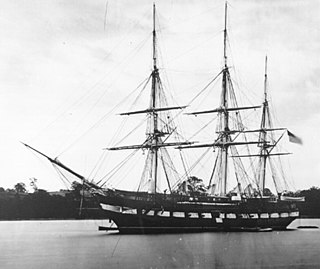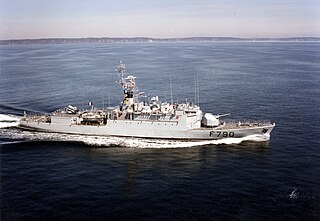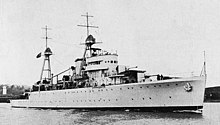
In naval terminology, a destroyer is a fast, maneuverable, long-endurance warship intended to escort larger vessels in a fleet, convoy, or carrier battle group and defend them against a wide range of general threats. They were originally conceived in 1885 by Fernando Villaamil for the Spanish Navy as a defense against torpedo boats, and by the time of the Russo-Japanese War in 1904, these "torpedo boat destroyers" (TBDs) were "large, swift, and powerfully armed torpedo boats designed to destroy other torpedo boats". Although the term "destroyer" had been used interchangeably with "TBD" and "torpedo boat destroyer" by navies since 1892, the term "torpedo boat destroyer" had been generally shortened to simply "destroyer" by nearly all navies by the First World War.

A frigate is a type of warship. In different eras, the roles and capabilities of ships classified as frigates have varied somewhat.

A corvette is a small warship. It is traditionally the smallest class of vessel considered to be a proper warship. The warship class above the corvette is that of the frigate, while the class below was historically that of the sloop-of-war.

A warship or combatant ship is a ship that is built and primarily intended for naval warfare. Usually they belong to the armed forces of a nation. As well as being armed, warships are designed to withstand damage and are typically faster and more maneuverable than merchant ships. Unlike a merchant ship, which carries cargo, a warship typically carries only weapons, ammunition and supplies for its crew. Warships usually belong to a navy, though they have also been operated by individuals, cooperatives and corporations.

In the 18th century and most of the 19th, a sloop-of-war in the Royal Navy was a warship with a single gun deck that carried up to eighteen guns. The rating system covered all vessels with 20 guns and above; thus, the term sloop-of-war encompassed all the unrated combat vessels, including the very small gun-brigs and cutters. In technical terms, even the more specialised bomb vessels and fireships were classed as sloops-of-war, and in practice these were employed in the sloop role when not carrying out their specialised functions.

The Flower-class corvette was a British class of 294 corvettes used during World War II by the Allied navies particularly as anti-submarine convoy escorts in the Battle of the Atlantic. Royal Navy ships of this class were named after flowers.

The Portuguese Navy is the naval branch of the Portuguese Armed Forces which, in cooperation and integrated with the other branches of the Portuguese military, is charged with the military defense of Portugal.

The D'Estienne d'Orves-class avisos, also known as the A69 type avisos, is a class of avisos, comparable in size to a light corvette, mainly designed for coastal anti-submarine defence, but are also available for high sea escort missions. Built on a simple and robust design, they have an economical and reliable propulsion system which allows them to be used for overseas presence missions. They were initially intended for use by the French Navy, but have been ordered by the South African Navy, Argentinian Navy and Turkish Navy.

Aeroposta Argentina S.A. was an early pioneering airline in Argentina established in the late 1920s, and a subsidiary of the French airmail carrier Aéropostale. It was created on September 5, 1927, as a subsidiary of the Aéropostale. In 1929, Aéropostale started expanding its airmail service within South America, and provided the first domestic air services on routes to Asuncion, Paraguay, Santiago de Chile, plus Bahía Blanca, Comodoro Rivadavia and Rio Gallegos in southern Argentina.

The Commandant Rivière class was a class of frigates built for the French Navy in the late 1950s and early 1960s. Labeled "aviso-escorteur", they were designed to perform the role of overseas patrol in peacetime and anti-submarine escort in wartime. This vessel class is named after the French Navy officer Henri Rivière (1827–1883).

The João Coutinho-class corvettes were a series of warships built for the Portuguese Navy for service in Portugal's African and Indian colonies. Initially rated as frigates, they were downgraded first to corvettes and then patrol vessels with age. They were designed in Portugal by naval engineer Rogério de Oliveira, but the urgent need of their services in the Portuguese Colonial War meant that the construction of the ships was assigned to foreign shipyards. Six ships were built; the first three ships were built by Blohm & Voss and the remaining three by Empresa Nacional Bazán. The ships were launched in 1970 and 1971. The relative cheap cost of the design led to it being the basis of several other classes in other navies. From 1970 until the end of the conflict in 1975, the corvettes were used for patrol and fire-support missions in Angola, Mozambique, Guinea and Cape Verde. After the African colonies gained their independence, the corvettes were assigned to patrol duties in Portuguese territorial waters.
When the United States entered World War II at the end of 1941, the United States Navy found itself deficient in ocean escort-type vessels. A crash building program was instituted; but, to meet more immediate needs, the government contracted with shipbuilding firms in England and Canada to build Flower-class corvettes. Vim (PG-99) was one of those British-type escorts. She was launched on 1 April 1943 at the Collingwood Shipyard in Collingwood, Ontario. Nine days later, however, she was transferred to the Royal Navy under the terms of the lend-lease agreement in return for another Flower-class corvette then under construction in Canada. The British renamed her HMS Statice, and she served the Royal Navy under the name through World War II. On 21 June 1946, she was returned to the United States Navy. Though carried on the Navy list as PG-99, the corvette never saw active service with the United States Navy. She was sold on 7 May 1947. To whom she was sold and to what purpose she was put is unknown.

ARA Alférez Sobral (A-9) is an 800-ton ocean-going tug that was in service with the Argentine Navy from 1972 until 2019, where she was classified as an aviso. She had previously served in the US Navy as the fleet tug USS Salish (ATA-187). In Argentine service an aviso is a small naval vessel used for a number of auxiliary tasks, including tugging, laying buoys, and replenishing other ships, lighthouses and naval bases.

An unprotected cruiser was a type of naval warship in use during the early 1870s Victorian or pre-dreadnought era. The name was meant to distinguish these ships from “protected cruisers”, which had become accepted in the 1880s. A protected cruiser did not have side armor on its hull like a battleship or “armored cruiser” but had only a curved armored deck built inside the ship — like an internal turtle shell — which prevented enemy fire penetrating through the ship down into the most critical areas such as machinery, boilers, and ammunition storage. An unprotected cruiser lacked even this level of internal protection. The definitions had some gray areas, because individual ships could be built with a protective deck that did not cover more than a small area of the ship, or was so thin as to be of little value. The same was true of the side armor on some armored cruisers. An unprotected cruiser was generally cheaper and less effective than a protected cruiser, while a protected cruiser was generally cheaper and less effective than an armored cruiser, with some exceptions in each case.

HMS Bideford was a Royal Navy Shoreham-class sloop. She was named after the town of Bideford in Devon and was launched on 1 April 1931.

SMS Zieten was the first torpedo-armed aviso built for the Imperial German Navy. She was built in Britain in 1875–1876, and was the last major warship built for Germany by a foreign shipyard. Ordered as a testbed for the new Whitehead torpedo, Zieten was armed with a pair of 38 cm (15 in) torpedo tubes, and was capable of a top speed of 16 knots, making her the fastest ship in the German fleet at the time. Zieten was the first torpedo-armed vessel in a series of avisos that ultimately developed into the first light cruisers. In addition to her impact in German warship design, Zieten also influenced numerous other navies, who built dozens of similar avisos and torpedo vessels of their own.

The French term Escorteur appeared during the Second World War to designate a warship, of a medium or light displacement, whose mission was to protect ocean convoys and naval squadrons from attacks by submarines. This role was in general handled by a destroyer escort such as the Buckley and Cannon classes built in the United States, or a Hunt-class destroyer built by the United Kingdom, or even a River class built by the United Kingdom, Canada and Australia. The Imperial Japanese Navy used the designation kaibokan for this type of ship.

The Arras class, sometimes known as the Amiens class, were a series of aviso built for the French Navy at the end of World War I.


















